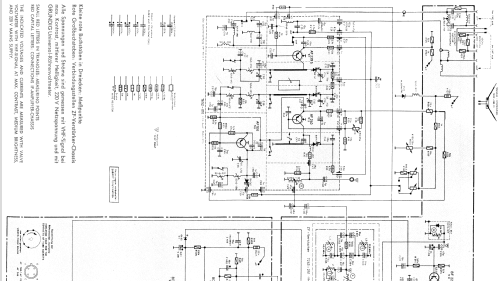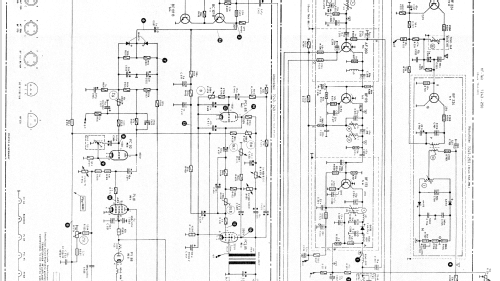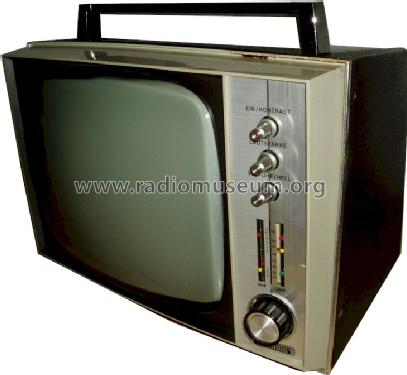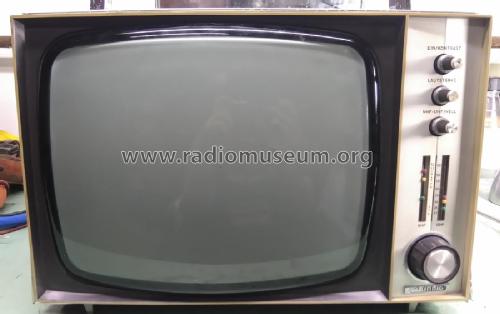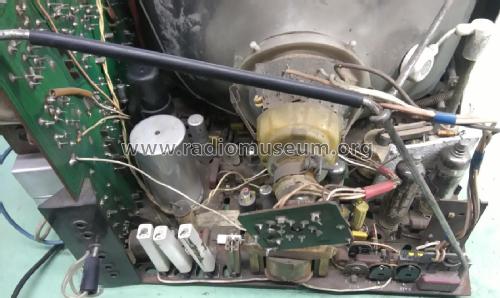Fernseh-Boy P1200
Grundig (Radio-Vertrieb, RVF, Radiowerke); Fürth/Bayern
- Country
- Germany
- Manufacturer / Brand
- Grundig (Radio-Vertrieb, RVF, Radiowerke); Fürth/Bayern
- Year
- 1967
- Category
- Television Receiver (TV) or Monitor
- Radiomuseum.org ID
- 121833
-
- alternative name: Grundig Portugal || Grundig USA / Lextronix
Click on the schematic thumbnail to request the schematic as a free document.
- Number of Tubes
- 6
- Number of Transistors
- 14
- Main principle
- Superheterodyne (common); ZF/IF 38900/5500 kHz; 2 AF stage(s)
- Wave bands
- VHF incl. FM and/or UHF (see notes for details)
- Power type and voltage
- Alternating Current supply (AC) / 220 Volt
- Loudspeaker
- Permanent Magnet Dynamic (PDyn) Loudspeaker (moving coil) - elliptical
- Material
- Bakelite or Plastics (type unknown)
- from Radiomuseum.org
- Model: Fernseh-Boy P1200 - Grundig Radio-Vertrieb, RVF,
- Shape
- Tablemodel, low profile (big size).
- Dimensions (WHD)
- 380 x 300 x 300 mm / 15 x 11.8 x 11.8 inch
- Notes
- Einige Transistortypen mehrfach vorhanden.
Die im Plan genannte Bildröhre C1248 ist falsch, es muss C1218 heißen.
(Siehe den unten folgenden Beitrag).
- Net weight (2.2 lb = 1 kg)
- 7.5 kg / 16 lb 8.3 oz (16.52 lb)
- Source of data
- - - Data from my own collection
- Literature/Schematics (1)
- Grundig Technische Informationen 3/1967
- Author
- Model page created by Enno Janke. See "Data change" for further contributors.
- Other Models
-
Here you find 6214 models, 5447 with images and 4211 with schematics for wireless sets etc. In French: TSF for Télégraphie sans fil.
All listed radios etc. from Grundig (Radio-Vertrieb, RVF, Radiowerke); Fürth/Bayern
Collections
The model Fernseh-Boy is part of the collections of the following members.
Literature
The model Fernseh-Boy is documented in the following literature.
Forum contributions about this model: Grundig Radio-: Fernseh-Boy P1200
Threads: 1 | Posts: 3
Es gibt einige Probleme, was die Bezeichnung der Bildröhre sowie die Bildröhre selbst betrifft:
Der Gesamtschaltplan des Tragbaren Fernsehgerätes wurde in den "Grundig Technischen Informationen" wie folgt abgedruckt:

dort ist die Bildröhre mit C1218 bezeichnet.
Im original-Schaltbild, welches mir auch vorliegt ist sie mit C1248 benannt:

Dreht man diese Seite um, so befinden sich dort die Technischen Daten des Gerätes, wo die Bildröhre wiederum mit "C1218" benannt wird.
Was stimmt nun? - ich denke der Typ "C1218" ist glaubwürdiger.
Weiß jemand mehr?
m.f.G
Hilmer Grunert
Hilmer Grunert, 27.Feb.08
